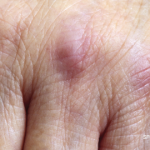(Reuters Health)—Young and middle-aged adults with polymyositis-dermatomyositis are more likely to have arrhythmias in general, and supraventricular arrhythmias in particular, than matched controls without these rare rheumatic conditions, a U.S. study suggests.1
Researchers examined retrospective data on adults hospitalized between 2016 and 2018, including 32,085 patients with polymyositis-dermatomyositis and 320,850 age-matched controls. Overall, both women and men up to age 70 years with polymyositis-dermatomyositis had a significantly higher adjusted odds of arrhythmia (aOR 1.4 and 1.3, respectively) than age-matched controls; there was no increased risk for those over 70.
When researchers looked at subtypes of arrhythmias, they found the increased risk for adults under 70 with polymyositis-dermatomyositis was only seen for supraventricular arrhythmias.
“We believe the prevalence of these arrhythmias was high in adults lower than 70 years of age because of higher inflammatory burden in young and middle-aged adults,” says lead study author Ashutossh Naaraayan, MD, of Montefiore New Rochelle Hospital, New Rochelle, N.Y.
“We know prevalence of arrhythmias increases with age and our hypothesis is after the age of 70, the effect of age on this prevalence overpowered the effect of inflammation from polymyositis-dermatomyositis, and thus there was no difference in arrhythmias in patients with or without polymyositis-dermatomyositis beyond 70 years of age,” Dr. Naaraayan says by email.
Patients with polymyositis-dermatomyositis had a significantly higher prevalence of all types of arrhythmias than age-matched controls (26.8% vs 22.7%), as well as atrial fibrillation (17.3% vs. 15.8%), atrial flutter (2.7% vs. 1.8%), supraventricular tachycardia (2.4% vs. 1.3%), and unclassified arrhythmias (2.4% vs. 1.3%).
All ages, and both sexes, with polymyositis-dermatomyositis who had an arrhythmia had an increased risk of in-hospital mortality (OR 3.3) compared to age-matched controls without an arrhythmia, the authors report in Heart Rhythm.1
One limitation of the study is the cross-sectional design that cannot establish a temporal relationship between polymyositis-dermatomyositis and arrhythmia, the authors note. The researchers also lacked data from ambulatory care settings such as physician’s offices and urgent care centers, as well as Veterans Affairs hospitals.
The biggest limitation is that the administrative claims data used for the analysis didn’t include several variables that might have influenced the results including medications and results from laboratory tests of inflammation, the authors acknowledge.
Still, the results highlight the importance of clinician awareness around the risk of arrhythmic events in patients with polymyositis-dermatomyositis that is similar to the risk seen with other chronic inflammatory diseases, says Dr. Pietro Enea Lazzerini, an associate professor of internal medicine at the University of Siena, Italy.
